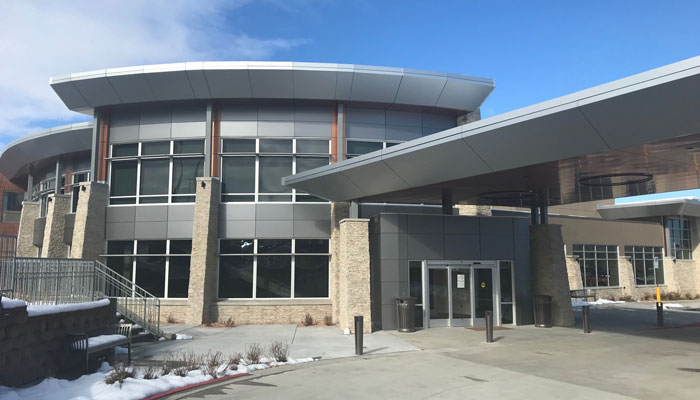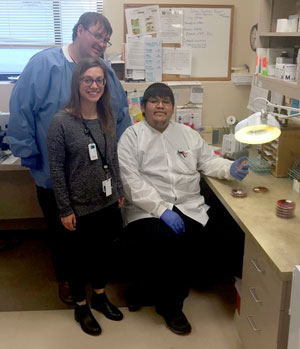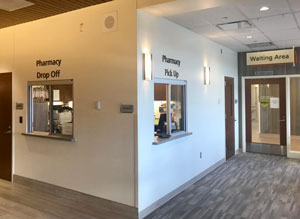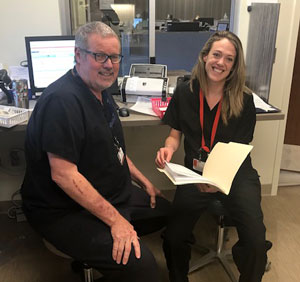Southwest Health System Antibiotic Stewardship Program
- Need: Impact patient care and safety issues related to antibiotic use in southwest Colorado.
- Intervention: Pharmacy-led antibiotic stewardship program for inpatient, outpatient, and long-term care settings.
- Results: With antibiotic use guidelines, refined infection diagnostics, and first-choice antibiotic selections, all care settings now see decreased days of treatment and decreased resistance patterns.
Description
Located in Cortez, Colorado, Southwest Health System (SHS) serves a population of 50,000 in rural Colorado, Arizona, New Mexico, and Utah. The organization also has ten clinics providing specialty and primary care. In addition, another healthcare organization has several long-term care (LTC) facilities totaling nearly 600 beds.

To bring antibiotic stewardship to the local area, SHS created an antibiotic stewardship (AS) program. The program started in the acute care setting of its 25-bed Critical Access Hospital (CAH) followed by implementation in both the outpatient and long-term care setting.
As is true for patients everywhere, antibiotics provide treatment for day-to-day common infections for outpatients in southwest Colorado. Additionally, the area's surgical patients, patients receiving chemotherapy, inpatients, and patients in long-term care facilities have increased infection risks that will need treatment. Antimicrobials are the drugs that save these patients' lives by killing infection-causing microbes. But microbes like bacteria are developing resistance to the antibiotics intended to kill common germs. According to the Centers for Disease Control and Prevention (CDC), 2 million patients develop infections caused by these resistant bacteria, and more than 20,000 patients die each year. In addition to developing resistance, antibiotics can also cause severe medication reactions. Another concern associated with antibiotics is the life-threatening infection caused by the unique bacteria Clostridium difficile (C. difficile).
To address these antibiotic- and infection-related issues, SHS prioritized the development of an AS program, the evidence-based comprehensive approach designed to preserve antibiotic effectiveness and minimizing antibiotic harm. The Association for Professionals in Infection Control and Epidemiology defines an AS program as "a coordinated program that promotes the appropriate use of antimicrobials (including antibiotics), improves patient outcomes, reduces microbial resistance, and decreases the spread of infections caused by multidrug-resistant organisms."

SHS's inpatient program started in 2014 and was pharmacist-led. Incorporating the CDC's recommended seven core elements, the program's initial efforts involved establishing baseline data along with creating simple, measurable goals focused on antibiotic choice and treatment duration: the right antibiotic for the right infection for right treatment duration, and in the right formulation (oral or intravenous).
Since antibiotic resistance and patient safety issues are not only a concern in the inpatient setting, stewardship activities then moved to SHS's 10 clinics followed by implementation in the LTC setting in 2016.
Initial AS startup was similar for all three types of care settings. Following the creation of the AS team — based on the CDC's leadership and accountability guidelines — collection of baseline data was followed by establishing treatment guidelines and a restricted-use antibiotic formulary for the hospital setting. Common infection treatment guidelines were also implemented for the clinic and LTC setting.
Because data analysis drives any AS program, SHS uses a commercial software program that scrubs data from the electronic health record (EHR) and provides a multifaceted analysis. For example, antibiotic use can be evaluated by diagnosis, by provider, or by department.

This software also allows SHS to share data with the CDC's National Healthcare Safety Network (NHSN), a national data bank for tracking healthcare-associated infections. Participation with NHSN further allows healthcare organizations to comply with the Centers for Medicare and Medicaid Services (CMS) infection reporting requirements. Another valuable feature of the NHSN is assistance with surveillance for antibiotic use and resistance (AUR) issues.
Services offered
In the CAH, the AS program's basic workflow aligns with goals of other hospital committees such as infection control, quality, and patient safety. The clinics and LTC facilities use a modified workflow based on the hospital program.
Inpatient Setting
AS team membership:
- Team Leader: pharmacist (also provides medication expertise)
- Physician champions: Emergency room physician and hospitalist
- Registered Nurse champions: RN educator and ICU clinical team member
- Lab professional
General workflow description:
- Guideline creation for infections such as community or hospital-acquired pneumonias, skin and soft tissue infections, and antibiotic prophylaxis for surgical procedures
- 48-hour antibiotic use/culture result review
- Daily rounding for approximately 1 hour
- De-escalation discussion (stop/continue/change formulation of current antibiotic treatment)
- Stewardship data reports:
- Reviewed by quality, infection prevention, and surgical committees
- Reviewed by medical executives and hospital board
- Data input into the NHSN AUR Module
Outpatient Setting (Including clinics and emergency room)

AS team membership:
- Team Leader: pharmacist (also provides medication expertise)
- Provider champions: Emergency room physicians, nurse practitioner, physician assistant
- RN champions: RN educator and RN clinical team members
- Lab professional
General workflow description:
- Treatment guidelines for urinary tract infections (UTIs) and upper respiratory infections (URIs) for adult and pediatric populations
- Initial baseline data now followed by data reports at specified intervals for provider review
Long term care (LTC) setting
AS team membership
- SHS hospital pharmacist provided initial consultation with a planned transition to facility lead physicians; later, a designated LTC organization pharmacist
- Director of Nursing or facility lead nurses joined as additional team members providing daily communication with ordering providers regarding antibiotic use and selection
General workflow description:
- Guidelines for diagnosis and treatment of UTIs
- Provider-created diagnostic workflow for evaluating possible UTIs
- Interval review of antibiotic use and resistance patterns
- Uses NHSN
Results

Results of initial inpatient interventions
- Decreased total antibiotic use by 30%
- Decreased surgical site infections (SSI)
- Improved facility resistance patterns
- Software tracking:
- Revealed problem antibiotic use areas for further focus and investigation
- Provider prescribing patterns for any needed review
Note: C. diff infection monitoring showed zero at baseline and no increases with stewardship program
Results of initial LTC facilities program
- 27% decrease in UTI diagnosis (treating symptomatic rather than asymptomatic UTIs)
For all three settings, the creation of a reliable antibiogram, a document showing bacterial resistance patterns and best antibiotic choices for infection with multi-drug resistant (MDR) data due to the regional presence of the SHS microbiology laboratory
For more information on Southwest Health System's AS program:
CDC's 2017 Antibiotic Use in the United States Progress and Opportunities. Southwest Health System: Pharmacist-led Antibiotic Stewardship in a Small Health System.
Challenges
- Provider resistance
- Dedicated staff time
Replication
- For any site implementing AS core elements, review current infection control activities, quality improvement strategies, and patient safety initiatives for a possible activity match with antibiotic stewardship core activities.
- Acknowledge that data tracking gives the program momentum, engages providers, and leads to trusted results.
- Each facility site should:
- Set goals which are simple, measurable, and limited in number
- Internally publicize results, a goal which keeps sites on a success track
- Readjust goals as needed
- Consider software investment saving time and allowing for granular data examination.
The following monographs may be helpful for implementation:
- For duration of infection treatment:
The New Antibiotic Mantra—"Shorter Is Better" - For hospital-based stewardship programs:
CDC's Implementation of Antibiotic Stewardship Core Elements at Small and Critical Access Hospitals - For Nursing Homes:
CDC's The Core Elements of Antibiotic Stewardship for Nursing Homes - For Community Outpatient Antibiotic Prescribers:
CDC's The Core Elements of Outpatient Antibiotic Stewardship - For addressing potential barriers:
National Quality Partners Playbook: Antibiotic Stewardship in Acute Care - Additional CDC information:
Antibiotic Use in Rural Hospitals as a Public Health Issue
Contact Information
Marc Meyer, R.Ph, BPharm, CIC, FAPIC, Director of Pharmacy, Infection Control and Infusion Center and Antibiotic Stewardship Program LeadSouthwest Health System
970.564.2194
mmeyer@swhealth.org
Topics
Critical Access Hospitals
· Hospitals
· Inpatient care
· Long-term care
· Outpatient care
· Pharmacy and prescription drugs
States served
Colorado
Date added
December 9, 2018
Suggested citation: Rural Health Information Hub, 2021 . Southwest Health System Antibiotic Stewardship Program [online]. Rural Health Information Hub. Available at: https://www.ruralhealthinfo.org/project-examples/1045 [Accessed 25 November 2025]
Please contact the models and innovations contact directly for the most complete and current information about this program. Summaries of models and innovations are provided by RHIhub for your convenience. The programs described are not endorsed by RHIhub or by the Federal Office of Rural Health Policy. Each rural community should consider whether a particular project or approach is a good match for their community’s needs and capacity. While it is sometimes possible to adapt program components to match your resources, keep in mind that changes to the program design may impact results.
